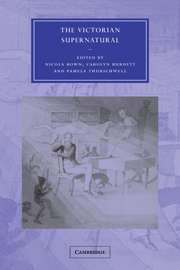Victorian Ghosts and Spectres
by Sonya Lane
Adding supernatural elements to literature is not a recent thing. From
Washington Irving’s Sleepy Hollow to
Emily Brontë’s Wuthering Heights,
ghosts have played a major role in much of the well-known literature of the 1800s.
It is no surprise that many of the great novels and stories are still widely
read today, especially those that contain the element of supernatural horror,
but why is this the case?
 The fascination with the
supernatural world in the Victorian Era can be somewhat explained by the new
technologies of the age. As Bown, Burdett, and Thurschwell say in The Victorian Supernatural, electricity,
telegraph wires, and the speedy railway started to transform the world, making
everyday life feel “uncanny”. Those technologies may seem normal today, but at
the time it caused people to question what they knew about reality.
The fascination with the
supernatural world in the Victorian Era can be somewhat explained by the new
technologies of the age. As Bown, Burdett, and Thurschwell say in The Victorian Supernatural, electricity,
telegraph wires, and the speedy railway started to transform the world, making
everyday life feel “uncanny”. Those technologies may seem normal today, but at
the time it caused people to question what they knew about reality.
Another explanation for the deep
interest in spectres is human fear. In his essay, Supernatural Horror in Literature, Howard Lovecraft takes a psychologist’s
standpoint by stating that the “oldest and strongest emotion of mankind is
fear, and the oldest and strongest kind of fear is fear of the unknown.” Since
the supernatural world can never be fully known, it is often accompanied by
fear. Whether this alone accounts for the continued appeal of the supernatural
or not, who can tell?
One thing is for certain; many Victorian writers leaned towards the Gothic
style that opened literary doors for ghosts everywhere. Although it seems ghosts
were already seeping through the walls. Washington Irving’s The Legend of Sleepy Hollow was
published in 1820, a good 17 years before the beginning of the Victorian
Period, but it contains similar aspects of Gothic horror as well as introducing
one of the most notable ghosts ever written about. What child doesn’t get
chills when talking about the Headless Horseman?
It may not
be considered Victorian literature per se, but The Legend of Sleepy Hollow fits right in with thrilling
supernatural works that came only a decade or two later. Washington Irving
paved the way for novels like A Christmas
Carol and other ghost stories such as The
Signal-Man.
Charles Dickens is the first name on the list when it comes to experts
on Victorian ghosts. He may be praised specifically for writing A Christmas Carol, but Dickens wrote ghosts
and spectres into many of his novels and short stories. The Signal-Man in particular shows how eerie spectres can be. The
narrator is an observer who becomes entangled in the story but is not the
character seeing ghosts, which gives the story a believable tone. As the
thrilling tale progresses the narrator wonders if the strange occurrences are
truly the work of spectres, then the strong ending leaves no doubt in the
narrator’s mind, and perhaps the reader’s mind also, that the supernatural
events could be real. That uncertainty draws readers and keeps the supernatural
genre alive.
Wuthering Heights is an example of using ghosts to
create the right mood in a novel that does not have a supernatural focus. Brontë
mixes the genre by periodically mentioning ghosts. First she uses it to paint a
picture of the daunting Wuthering Heights manor that Mr. Lockwood visits. He
stays in Catherine’s old room and has an encounter with the ghost of a child
who might be Catherine (67). Even though ghosts are not the topic of the novel,
they persist from that moment until the last page when a passing boy claims to
have seen the dead Heathcliff and Catherine. It is uncertain whether the
narrator believes the boy, but that uncertainty is exactly what keeps the
reader from forgetting this novel too quickly.
The heavy use of the supernatural element in Victorian literature sets
it apart. Ghost stories have existed as long as someone existed to tell them,
and will continue to exist, but the gothic style of Victorian writers brought
out superstitions and ghosts in droves. The reasons for this can be speculated
on, as well as the explanation for mankind’s intense interest in the
supernatural, but it might be more fun to remain uncertain. What makes people
shiver when the lights go out? What causes the hair on the back of our neck to
stand up? Is it the ghost stories everyone has heard, or is it instinct trying
to protect us?
Bibliography
Bown, Nicola, Carolyn Burdett, and Pamela Thurschwell. The
Victorian Supernatural. Cambridge University Press, 2004. Print.
Brontë, Emily. Wuthering
Heights. Penguin Books, 1847. Print.
Dickens, Charles. Three
Ghost Stories: The Signal-Man. Project Gutenberg, 2013. e-book.
Irving, Washington. The
Legend of Sleepy Hollow. 1820. Digi-Media-Apps, 2013. Web.
Lovecraft, Howard Phillips. Supernatural Horror in Literature.
Courier Corporation, 1945. Print.


